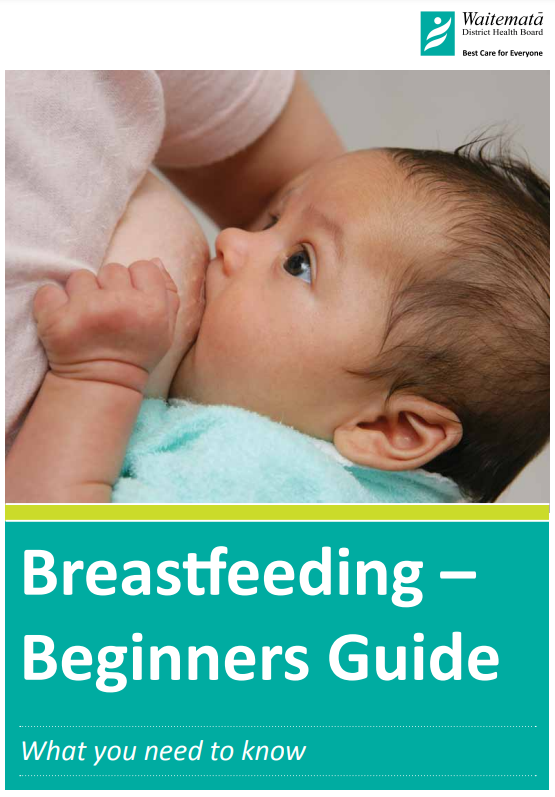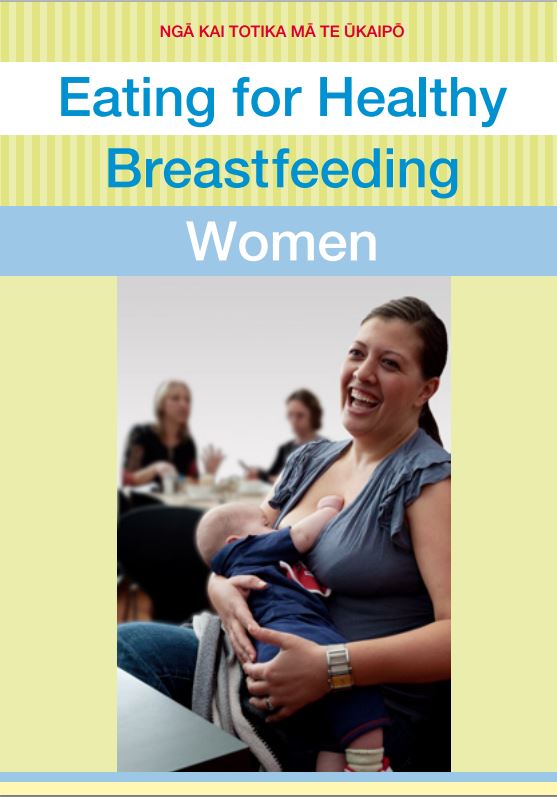Wishing everyone happy holidays and a joyful New Year from the Healthify team. Don't forget to Slip, Slop, Slap and Wrap!
Breastfeeding – basics
Key points about breastfeeding
- Breastmilk meets all the nutritional requirements for your pēpi's healthy growth and development for the first 6 months of life.
- From around 6 months, your baby should continue to breastfeed while being gradually introduced to appropriate family foods. Breastfeeding should continue until your baby is at least 1–2 years old, or longer if it suits mother and baby.
- Breastmilk has many benefits. It is free, easy for your baby to digest and helps keep your baby healthy by protecting against infections and allergies.
- Making the decision to breastfeed your pēpi is one of the best decisions you will make as a parent.
- However, if you are having trouble breastfeeding, don't struggle alone. There is support available.

It is free, safe and environmentally friendly. It is also ready for use at a moment's notice, making breastfeeding very convenient.
- Breastmilk is easily digested and very unlikely to cause your baby to become constipated, which formula can do.
- It changes as your baby's needs change. The amount of milk and its composition (what it is made up of) changes according to the time of day, how often you breastfeed and the age of your baby. This happens automatically to promote healthy growth of your pēpi.
- Breastfeeding helps protect your baby against infections, eg, gastrointestinal and respiratory illnesses. The first milk (colostrum) is particularly high in the mother's protective antibodies. There's even evidence that breastfeeding mothers who are vaccinated against COVID-19 can pass along antibodies to the virus through their breastmilk. These antibodies may help protect your baby if they are still too young for the vaccine.
- It reduces the risk of allergies and asthma.
Video: What are the health benefits of breastfeeding?
This video may take a few moments to load.
Mothers who breastfeed have a reduced risk of:
- Type 2 diabetes
- Some types of breast cancer
- Ovarian cancer
- High blood pressure (hypertension) and cardiovascular disease
- Hip fractures and reduced bone density (osteoporosis) in later life.
Mothers share their thoughts on the bonding experience of breastfeeding.
Video: What is the best food for my baby?
This video may take a few moments to load.
Making the decision to breastfeed your tamariki is one of the best decisions you will make as a parent. Almost all women are physically able to breastfeed and produce enough milk.
How you feel about breastfeeding will be affected by a wide range of experiences from your own childhood as well as that of your parents, whānau, friends and workmates. How you feel about your body and the quality of your relationships with your family/whānau, friends and partner will also be important.
Making milk is only one part of breastfeeding. Adjusting to your changing shape while managing your expectations of yourself, your family and your partner, and your own past experiences all contribute to successful breastfeeding.
Make sure you have someone you can really count on to support you in your decision to breastfeed your child. Practical and moral support really helps. Read more about practical ways to support a breastfeeding parent.(external link)
While breastfeeding is natural, it is not uncommon to experience challenges with it. If you are having trouble breastfeeding don't struggle alone – ask for help. Talk to your midwife or a lactation consultant. You can also find tips and advice on our pages on common breastfeeding problems and what to do if you can't breastfeed.
Like all new skills, breastfeeding comes easier to some than others. You and your baby may only take a couple of days to become good breastfeeding partners or it may take up to 6 weeks. Remember that most of the women you see casually feeding their babies at bus stops or cafés have been feeding for quite a while – and like most things, practice makes perfect. When you feel more comfortable about breastfeeding and your milk is well established you will be able to breastfeed anywhere.
The first feed should be soon after the birth. Your baby will be skin-to-skin against your bare chest as soon after birth as possible and will stay there until the first breastfeed, or for at least an hour, to encourage breastfeeding. The first milk your baby receives when put to your breast is called colostrum. This first, or early, milk is a yellow fluid that contains all the nutrition your baby needs for the first few days of life. Colostrum is also full of antibodies, which help protect your baby from bacteria and makes their immune system strong. A baby's puku (tummy) is very small at birth and the amounts of colostrum available in the first few days are perfect for your baby.
In the first few days most newborns feed frequently, at least 8 times in 24 hours and even as often as every 1-2 hours. This frequent feeding helps you to bring in the mature milk which appears around day 3–4 after birth. It looks thinner and whiter and increases in quantity.
Writing about how to position a baby correctly on the breast is a bit like writing instructions for how to knit – it is much easier to be shown. Your midwife will help you and your baby get breastfeeding started. Every woman and baby develop their own breastfeeding style. There are several positions that can be used to help your baby latch on. Read more about breastfeeding positions(external link)
As newborn babies do not yet have full control of their heads, you will need to gently position your baby’s mouth near your nipple. Most midwives spend some time helping you attach, or latch, your baby to your breast correctly. This is because most problems that occur with breastfeeding are caused by the baby not positioning their mouth correctly on the breast.
Before each feed
- Take time to position yourself comfortably, so that you are relaxed.
- Use some pillows to support yourself or baby (particularly during the first few weeks or months).
- Unwrap your baby's arms so they can explore your face and breast and ensure their body is well supported.
- Have your baby's mouth at the same level as your nipple.
- Baby’s mouth should go over your nipple and areola (the brown area around the nipple).
After the feed
- To release the nipple, break the suction by gently placing your finger in the corner of the baby's mouth.
- Do not pull the baby off without doing this as you will hurt your nipple.
The let-down reflex
The ‘let-down’ is the reflex action that allows the milk to be released into the milk ducts. You may notice that the uterus contracts when the milk lets down in the early days of breastfeeding. You may also notice a tingling, pins and needles feeling or fullness and/or milk leaking from your breast. Not all women do experience these though and it is normal either way.
If you have sore nipples or are feeling anxious you can have problems with the let-down of milk. The following tips might help:
- Placing your baby skin-to-skin on your chest between your breasts.
- Gentle breast massage.
- Applying a warm face cloth to your breast.
- Having a warm shower.
Supply and demand feeding
The best way to build up and maintain your milk supply is to follow your baby’s lead – feed whenever your baby is hungry! At first, your baby will need to feed at least 8-12 times (or more!) in 24 hours. Learn more about how to know if your baby is hungry(external link)(external link). The more your baby feeds and removes milk from your breasts, the more milk you will make. If your breasts remain full, milk is produced more slowly. Your baby will control their milk intake, so feed for as long as your baby wants.
Video: What are the hunger cues for breastfeeding?
This video may take a few moments to load.
Many mothers worry about whether their baby is getting enough milk. However there are a few things that will reassure you that your baby IS getting enough.
- Your baby is feeding at least 8-12 times in 24 hours including during the night.
- You hear frequent swallows throughout the feed and your breast feels softer after feeding.
- Your baby releases the breast on their own and appears content after a feed.
- Your baby is having 6–8 wet nappies by the time they are 5–6 days old.
- Your baby is having at least 3 yellow, loose ‘seedy’ looking bowel motions (poos) by 5 days old. If your baby does not have several dirty nappies each day in the first month of life, please talk with your midwife. This can sometimes be a sign that your baby is not getting enough milk.
Some signs that your baby may not be getting enough milk are:
- If your baby is sleepy or lethargic at breast and going long periods between feeds.
- If your baby has not regained birth weight by 14 days old or weight gain is slower than expected.
- If your baby is not having enough wet and/or dirty nappies.
- If latching is painful – a poor latch can mean that your baby is not getting enough milk.
It is best if you don't use bottles, teats and pacifiers (dummies) while you and your baby are settling into breastfeeding. Pacifiers (dummies) used in the early days of breastfeeding can reduce how often your baby breastfeeds and this can make it harder for you to develop a good milk supply. If you need to be away from your baby and need someone else to feed them, it may be helpful to introduce the bottle with expressed breastmilk to your baby after 4 weeks of age. Learn more about how to express breastmilk.
If you are worried about how your baby is feeding, ask to have a breastfeeding assessment. Your midwife or lead maternity carer (LMC) can refer you to an International Board Certified Lactation Consultant (IBCLC) for an assessment. A lactation consultant is a professionally trained breastfeeding specialist. The referral process will vary across the country and your midwife/LMC will know who to refer you to in your area.
During the assessment, a lactation consultant will talk to you about your baby's feeding. They will watch your baby breastfeeding and help you to adjust your breastfeeding technique if necessary. You and your baby can have a breastfeeding assessment as early as 2 days after they are born if your baby has severe feeding problems. Always talk to your midwife if you are worried.
You can also talk to a PlunketLine nurse on 0800 933 922. Calls are free and PlunketLine is available 24/7. They'll do an assessment and can book you an online appointment with one of Plunket's lactation consultants. These breastfeeding consultations are free and available for all breastfeeding women, even if Plunket isn’t your WellChild provider.
You can also look at SmartStart(external link)(external link) to find breastfeeding support services in your area.
Tiredness is common in the early days after giving birth. If you can, sleep or rest when your baby is sleeping between feedings. Have your whānau help with household chores and meals so that you can rest more. Eat healthy food and snacks throughout the day and drink plenty of fluids to stay hydrated.
Spend time with other mothers and their babies, but resist the temptation to compare your baby with other babies. Each baby is special and different.
The sudden changes the birth of a baby brings can be confusing, and the new demands can affect your personal life and relationships. Any problems should be discussed and dealt with as soon as possible. Encourage your partner to talk to you and/or their friends about any problems that arise.
If you are continuing to breastfeed when returning to work, watch this video for tips and ideas.
Video: Breastfeeding. Naturally. Chapter 7: Returning to Work
Additional tips for looking after yourself
- Avoid cigarette smoking while breastfeeding.
- It is better to avoid alcohol while breastfeeding, especially during the first month. If you do choose to drink, it is safest to follow these guidelines.
- Most medicines are safe to take while you're breastfeeding. However, some can enter your breastmilk so get advice from your doctor, midwife or pharmacist before taking any medicines. Read more about breastfeeding and medicines.
- Some oral contraceptives can affect your milk supply. Check with your midwife or doctor about breastfeeding-friendly options for contraception, and read about breastfeeding and contraception.
- Exercise has many benefits in breastfeeding mothers but trying to fit it in with the demands of a young family can be challenging.
Video: The Joy Series Video 10 - Breastfeeding and exercise
(Breastfeeding NZ, 2016)Baby Friendly Aotearoa NZ(external link)
Breastfeeding(external link) Health New Zealand | Te Whatu Ora
Steps and signs of a good latch(external link) WIC Breastfeeding Support, US
Resources
For breastfeeding support, go to our Support page
Breastfeeding your baby(external link) HealthEd, NZ, 2021 English(external link), Chinese (simplified)(external link), Korean(external link), te reo Māori(external link), Samoan(external link), Tongan(external link)
Breastfeeding – beginners guide [PDF, 889 KB] Auckland DHB and Waitematā DHB, NZ, 2021 English [PDF, 889 KB], Chinese [PDF, 1.1 MB], Thai [PDF, 685 KB]
Eating for healthy breastfeeding women(external link) HealthEd, NZ, 2022
Breastfeeding & working(external link) HealthEd, NZ, 2022 English(external link), Samoan(external link), Tongan(external link)
Wai ū – Ko te whenua te wai ū mō te tangata Hāpai SUDI Prevention Co-ordination Service, NZ
Your guide to breastfeeding(external link) La Leche League and Ministry of Health, NZ, 2018
Milk supply(external link) La Leche League and Ministry of Health, NZ, 2018 English(external link), te reo Māori(external link), Samoan(external link), Tongan(external link), Niuean(external link)
The joys of breastfeeding(external link) La Leche League and Ministry of Health, NZ, 2018 English(external link), te reo Māori(external link), Samoan(external link), Tongan(external link), Niuean(external link)
Breast problems – sore breasts(external link) La Leche League and Ministry of Health, NZ, 2018 English(external link), te reo Māori(external link), Samoan(external link), Tongan(external link), Niuean(external link)
Breast problems – swollen breasts(external link) La Leche League and Ministry of Health, NZ, 2018 English(external link), te reo Māori(external link), Samoan(external link), Tongan(external link), Niuean(external link)
Breastfeeding basics(external link) Health Information Translations, US, 2018 English(external link), Arabic/English(external link), Chinese (simplified)/English(external link), Chinese (traditional)/English(external link), French/English(external link), Hindi/English(external link), Japanese/English(external link), Nepali/English(external link), Russian/English(external link), Somali/English(external link), Spanish/English(external link), Vietnamese/English(external link), more languages(external link)
Note: This resource is from overseas so some details may be different in New Zealand, eg, phone 111 for emergencies or, if it’s not an emergency, freephone Healthline 0800 611 116.
Getting started breastfeeding your baby (external link)Health Information Translations, US, 2018 English(external link), Arabic/English(external link), Chinese (simplified)/English(external link), Chinese (traditional)/English(external link), French/English(external link), Hindi/English(external link), Japanese/English(external link), Korean/English(external link), Nepali/English(external link), Russian/English(external link), Somali/English(external link), Spanish/English(external link), Vietnamese/English(external link)
Note: This resource is from overseas so some details may be different in New Zealand, eg, phone 111 for emergencies or, if it’s not an emergency, freephone Healthline 0800 611 116.
Your new baby (external link)Health Information Translations, US, 2019 English(external link), Arabic(external link), Chinese (simplified)(external link), Chinese (traditional)(external link), French(external link), Hindi(external link), Japanese(external link), Korean(external link), Nepali(external link), Russian(external link), Somali(external link), Spanish(external link), Vietnamese(external link)
Note: This resource is from overseas so some details may be different in New Zealand, eg, phone 111 for emergencies or, if it’s not an emergency, freephone Healthline 0800 611 116.
References
- Perl SH, Uzan-Yulzari A, Klainer H, et al. SARS-CoV-2–Specific antibodies in breast milk after COVID-19 vaccination of breastfeeding women(external link)(external link)JAMA. 2021;325(19):2013–2014.
- Breastfeeding(external link) Centers for Disease Control and prevention, US, 2021
Duan X, Wang J, Jiang X. - A meta-analysis of breastfeeding and osteoporotic fracture risk in the females(external link)(external link). Osteoporos Int. 2017 Feb;28(2):495-503.
Information for healthcare providers on breastfeeding
The content on this page will be of most use to clinicians, such as nurses, doctors, pharmacists, specialists and other healthcare providers.
Clinical resources
Breastfeeding(external link) Health New Zealand | Te Whatu Ora
The Academy of Breastfeeding Medicine(external link) US
Breastfeeding at work(external link) Employment NZ
Drugs and lactation database (LactMed)(external link) National Library of Medicine, US
COVID-19 vaccination in pregnant and breastfeeding women and those planning pregnancy(external link) RANZCOG, 2022
Drug safety in lactation(external link) Medsafe, NZ
Mama Aroha(external link) Tools to enable healthcare providers empower all mothers to breastfeed
Brochures

Auckland DHB and Waitematā DHB, NZ, 2021
English, Chinese,Thai

HealthEd, NZ, 2022
Credits: Healthify Editorial Team. Healthify is brought to you by Health Navigator Charitable Trust.
Reviewed by: Cara Hafner, Registered Nurse and Lactation Consultant, NZ Breastfeeding Alliance, Christchurch
Last reviewed:
Page last updated:






